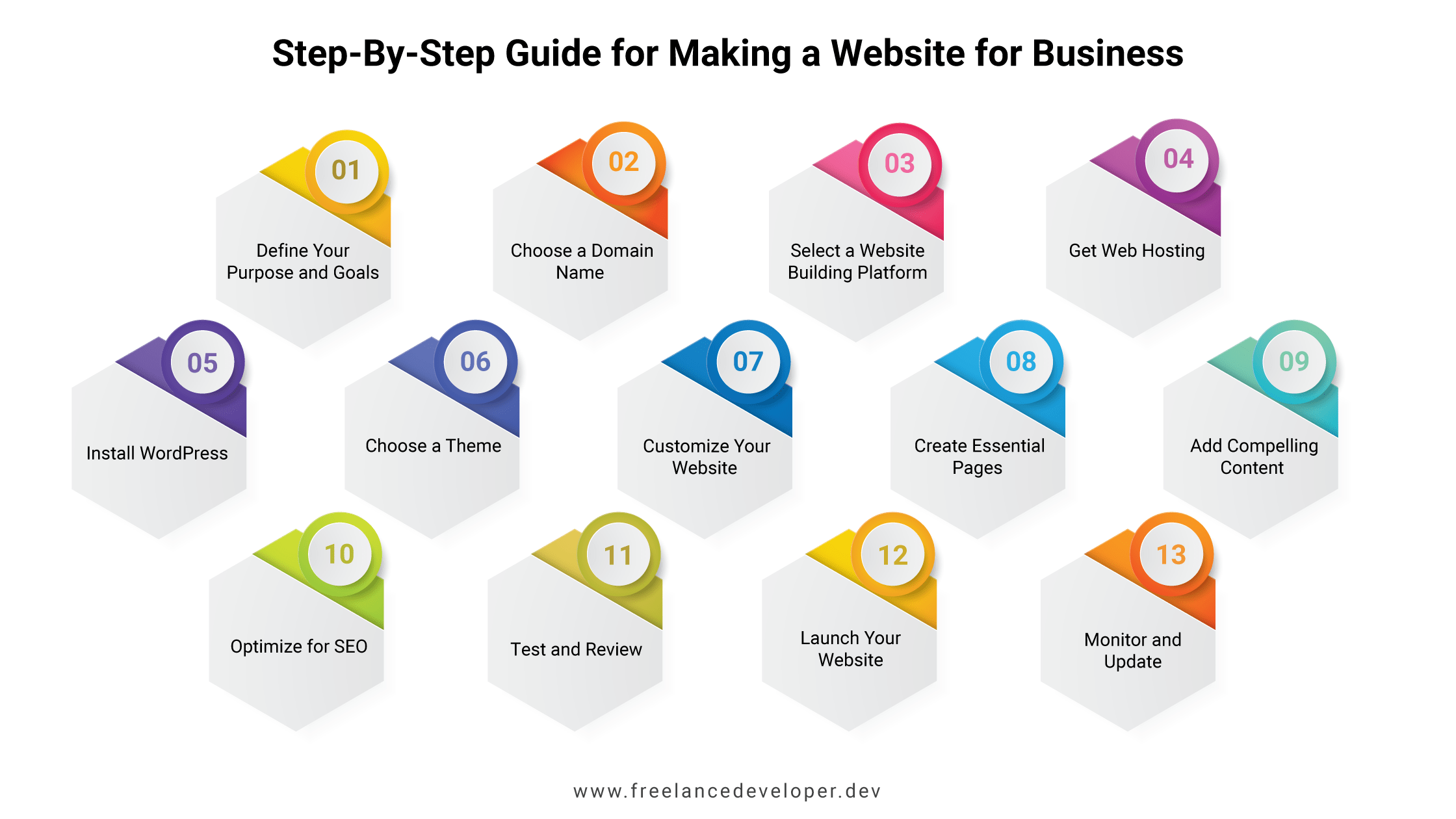TABLE OF CONTENTS
In today’s digital world, small businesses must be online. A good website can help you show your stuff to lots of people, prove you’re trustworthy, and even grow your business. But if you’re new to making websites, it might seem scary. Don’t worry! This guide will show you, step by step, how to make a website for your small business. We’ll use simple words and examples to help you along the way.
Think of this guide as your friendly helper, guiding you to create one of the best startup websites out there. I’ll explore how to use a website maker for small businesses, turning your ideas into a website that people will love. By the end, you’ll know how to make a business website that shines in the digital world. So, let’s get started on this journey to make your business a star online!
The Importance of a Website for Small Businesses

In the digital age, a website has become the cornerstone of a small business’s online presence. It is not merely a digital brochure but a dynamic tool that plays a pivotal role in the success of small enterprises. Let’s explore why having a website is crucial for small businesses.
Establishing Credibility
- Building Trustworthiness: In an era when consumers rely heavily on the internet for information, a well-designed website conveys professionalism and legitimacy. It's often the first point of contact for potential customers, and a polished website can make a lasting positive impression.
- 24/7 Accessibility: A website ensures round-the-clock accessibility. Your business is open even when you're not. Customers can browse your offerings, access contact information, and make inquiries at their convenience.
Expanding Reach
- Global Visibility: A website breaks geographical boundaries, making your business accessible to a global audience. With effective search engine optimization (SEO), your site can rank well in search results, attracting organic traffic from around the world.
- Marketing and Engagement Hub: Your website serves as a central hub for your digital marketing efforts. You can showcase products, services, promotions, and brand identity. Engage with your audience through blog posts, videos, and customer testimonials, fostering a sense of community and trust.
How a Website Helps Small Businesses Grow Online
Building Customer Databases
- Data Collection: Through contact forms, newsletter sign-ups, and online purchases, your website collects valuable customer data. This data includes email addresses, preferences, and behaviors, which can be used for targeted marketing efforts.
- Targeted Marketing Campaigns: Leveraging the collected data, you can create personalized marketing campaigns. Send tailored promotions, product recommendations, or informative content to specific segments of your audience, increasing the chances of conversion.
Measurable Growth
- Website Analytics: Modern websites are equipped with analytics tools that provide detailed insights into visitor behavior. Monitor which pages are popular, where visitors drop off, and where conversions occur. Use these insights to optimize your website and marketing strategies.
- Informed Decision-Making: With data-driven insights, you can make informed decisions about marketing budget allocation, content strategy, and product/service offerings. Identify areas of improvement and capitalize on successful strategies to fuel growth.
For small businesses, a website is more than just a digital presence; it’s a gateway to credibility, expanded reach, customer engagement, and data-driven growth. Embracing the potential of a well-designed website is essential in the digital age, as it can empower small enterprises to compete effectively and thrive in the online marketplace. It’s an investment that pays dividends by fostering trust, connecting with a global audience, and providing the tools needed for informed and strategic growth online.
Step-By-Step Guide for Making a Website for Business

Step 1: Define Your Purpose and Goals
Before diving into website creation, it’s crucial to define the purpose and goals of your website. Ask yourself:
- What do you want to achieve with your website?
- Who is your target audience?
- What kind of content will you feature?
- What actions do you want visitors to take on your site?
For example, if you’re a local bakery, your goal might be to showcase your delicious cakes, attract more customers, and provide contact information for orders.
Step 3: Select a Website Building Platform
There are several website building platforms available, and many of them are user-friendly, making website creation easier for beginners. Here are a few popular options:
- WordPress: WordPress is a highly versatile and widely used content management system (CMS). It offers a vast library of themes and plugins, making it suitable for various website types, from blogs to e-commerce stores.
- Wix: Wix is known for its user-friendly drag-and-drop website builder. It offers a range of visually appealing templates and is an excellent choice for beginners.
- Shopify: Shopify is a specialized e-commerce platform designed for online stores. It provides a wide range of tools for selling products and managing inventory.
- WooCommerce: WooCommerce is a plugin for WordPress that transforms your site into an e-commerce powerhouse. It's highly customizable and integrates seamlessly with WordPress.
- BigCommerce: BigCommerce is another e-commerce-focused platform known for its scalability and robust features. It's suitable for businesses of all sizes.
- GoDaddy Website Builder: GoDaddy's website builder is a straightforward option with hosting included. It's beginner-friendly and offers various templates.
- Joomla: Joomla is another CMS similar to WordPress, offering flexibility and scalability. It's suitable for building complex websites with advanced features.
- Drupal: Drupal is a highly customizable and powerful CMS used for creating robust websites. It's favored by developers and organizations for its flexibility.
These website building platforms cater to a wide range of needs and skill levels, so you can choose the one that best suits your project and expertise. For our example, we’ll use WordPress due to its versatility.
Step 4: Get Web Hosting
Web hosting is like renting space on the internet for your website. Many website building platforms, including WordPress, require web hosting. Some hosting providers, like Bluehost or SiteGround, offer easy WordPress installations.
Step 5: Install WordPress
Once you’ve acquired web hosting, you can install WordPress with just a few clicks. Hosting providers often offer one-click installations for WordPress. After installation, you can access your website’s dashboard.
Step 6: Choose a Theme
Selecting a theme is like choosing the design and layout of your website. WordPress offers a vast selection of free and premium themes. Choose one that suits your business’s style and needs. For our bakery example, a theme with a visually appealing design showcasing images of your cakes would be ideal.
Step 7: Customize Your Website
With your theme in place, you can now customize your website:
- Site Identity: Set your site title and tagline.
- Colors and Fonts: Choose a color scheme and fonts that align with your brand.
- Header and Footer: Add a logo, navigation menu, and contact information.
- Widgets: Add useful widgets like a search bar, social media links, and business hours.
Step 8: Create Essential Pages
Now, it’s time to create the essential pages for your website:
- Home: An introduction to your business.
- About Us: Information about your company's history, values, and team.
- Products/Services: Showcase what you offer with descriptions, images, and prices.
- Contact: Provide contact details, a contact form, and a map if you have a physical location.
For our bakery, the “Products” page could feature categories like “Cakes,” “Cookies,” and “Pastries,” each with mouth-watering images and descriptions.
Step 9: Add Compelling Content
High-quality content is key to engaging visitors and improving search engine rankings. Write engaging copy that tells your brand’s story and highlights your products or services. Use images and videos to make your content more appealing. For instance, for our bakery, you could include images of your delectable treats and videos showing your baking process.
Step 10: Optimize for SEO
Search Engine Optimization (SEO) helps your website rank higher in search engine results. Use relevant keywords in your content, optimize images with descriptive alt tags, and ensure your website loads quickly. Consider installing an SEO plugin like Yoast SEO (for WordPress) to help you optimize your content effectively.
Read the Related Blogs Here:
8 Best WordPress Appointment and Booking Plugins in 2023
7 Useful WordPress Redirect Plugins for 2023
Step 11: Test and Review
Before launching your website, thoroughly test it. Ensure that all links work, forms function correctly, and content is displayed as intended. Review your site on various devices (desktop, tablet, and mobile) to ensure it looks good and functions well everywhere.
Step 12: Launch Your Website
Congratulations! You’re ready to launch your small business website. Announce it on social media, email newsletters, and any other marketing channels you have. Encourage your friends, family, and customers to visit your site and provide feedback.
Step 13: Monitor and Update
Your website is a dynamic tool. Regularly monitor its performance using tools like Google Analytics. Listen to user feedback and make updates as needed to keep your website fresh and engaging.
Building a small business website doesn’t have to be overwhelming. By following these steps and using user-friendly platforms like WordPress, you can create a professional and effective online presence for your business. Remember, your website is often the first impression potential customers have of your business, so make it count!
Conclusion:
Your website is your window to the world, your platform for showcasing what you offer, and your ticket to earning trust from potential customers. The journey of creating a website for your business may seem intimidating, especially if you’re new to it. However, with the help of this straightforward guide, you’ve taken the first steps toward developing one of the best startup websites out there.
I’ve covered the essentials of using a website maker for small businesses and walked through the process step by step. By now, you should feel more confident in your ability to create a compelling online presence for your business. If you’re ready to take the next steps or have questions, remember that my expertise is at your service. Feel free to reach out for a free consultation on website development, and let’s turn your small business into a digital success story. Together, we’ll make your business website shine in the competitive online world!
Latest Blogs

As a blog author, I have a strong passion for staying up-to-date with the latest trends and technologies. My expertise lies in WordPress development, SEO optimization, and content writing. Whether you have an idea for a website, I am offering a free consultation call to guide you. I am also available to provide the best SEO and content writing services to boost your online presence.







